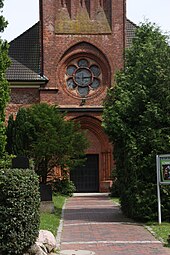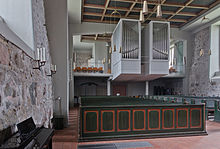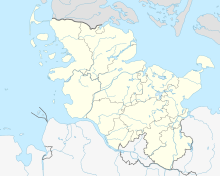Friedenskirche (Siek)
The Evangelical Lutheran Church of Peace in Siek in the Stormarn district is located there with its churchyard and the former cemetery dominating the center of the village.
history
Parish
The place Siek was first mentioned in writing in 1263. The first church was probably built around this time. It was one of the oldest church buildings in Stormarn .
The parish of Siek was first mentioned in a document in 1304 and comprised a total of 15 villages by 1320. The Hamburg Mariendom has been the bishop's and baptismal church for Stormarn since the 12th century . The cathedral chapter acquired 16 Stormarn villages through purchase and donation between 1250 and 1350, including Siek, which was sold on to the Reinbek monastery in 1344 . The Reformation led to the dissolution of the monastery in 1529 and Siek came into the possession of the Danish King Friedrich I.
Medieval church
The first church was built in the 13th century, initially without a choir made of field stone and later expanded at least three times. This first church was finally 31 meters long and 16 meters wide. The field stone walls were extraordinarily strong with a thickness of up to 1.40 meters. During the Baroque period , a 40-meter-high clapboard-roofed church tower was built into the western gable. This tower has served as a trigonometric base point since the measurement of the Danish kingdom by Carl Friedrich Gauß and Heinrich Christian Schumacher . The church had an organ, the bronze baptism that has survived to this day, and an altar by Hein Baxmann .
Neo-Gothic new building
In 1880 the church was struck by lightning and burned down. The bronze baptism and the panels on the altar were saved from the burning church by the Sieker carpenter Gehrmann and his journeymen. The walls of the church were not damaged by the fire and could for the most part be used for the new building, which was built from 1880 to 1883 in the neo-Gothic style.
The new tower now rose 53 meters and continued to serve as a trigonometric base point for land surveying. The windows on the long sides were emphasized by dormer-like structures in the roof. Behind the altar there were three narrow lead-glazed windows, inside on the two long sides wooden galleries . The ceiling in the interior was structured by a three-bay vault. The saved panels from the previous altar were set into the new altar structure. This new altar, like the church, was built in neo-Gothic style and was characterized by emerging lines.
Reconstruction 1954–1956
A hurricane-like storm in January 1954 buckled the top of the church tower. The subsequent investigations revealed further damage to the roof and cracks in the vault. Further use of the church was then forbidden and from 1954 to 1956 extensive renovation and reconstruction work took place, through which the character of the church was again significantly changed. The roof, the vaults and the facing masonry were completely removed, and the original granite masonry was now visible again. The dormers and the neo-Gothic windows were also removed and rectangular windows were installed instead. A concrete corset was drawn in inside the church and the three high windows behind the altar were bricked up. The wooden pulpit with its pulpit roof and the galleries have been removed. The neo-Gothic elements on the altar were removed and a reshaping was carried out in the Renaissance style . In 1958 an organ was installed and in 1962 the renovation was completed with the consecration of three new bells.
In 1995 the roof of the church tower was twisted in a hurricane-like storm. The tower could be stabilized by installing a steel skeleton. Since then, the weight of the belfry has been transferred to the old field stone walls below the tower rose, which was installed in 1883.
Interior
altar
The altar shows no direct reference to the artist, but the stylistic comparison shows that the altar is undoubtedly by Hein Baxmann . The altar can be classified between the Baxmann altars in Allermöhe and Ochsenwerder , so that it was built around 1620. It is not known how the altar came to Siek. Nothing is known about the original appearance before the fire in 1880. The relief panels from oak were rescued from the burning church, but it probably damaged and abgebeitzt possibly existing painting in the series. After the church was rebuilt in 1883, a neo-Gothic altar frame was made and the relief panels and figures that had been saved were inserted. In 1955, the altar was given a case that should come close to the original from 1620. Because of the lack of tradition, the Baxmann Altar from Allermöhe was used as a basis and attempts were made to indicate the transition from Renaissance to Baroque that was taking place at that time . The two obelisks at the end of the main part and the aedicula with the figure of Christ on it are assigned to the Renaissance, while the volutes on the sides represent the Baroque.
Bronze baptism
The bronze baptismal font comes from the Lübeck master Gerhard Kranemann and was made around 1350. The fifth has three feet, which are formed as mythical creatures with animal feet, a tail and bearded male faces. The cauldron has Latin inscription in Gothic minuscule : Magister gherardus fecit me cuius anima et hinrici Ulmtle's Requiescant in pace ; in German Master Gerhard made me. May his soul and that of Heinrich Ulmtle rest in peace. It is believed that the baptism came to Siek as a bargain purchase around 1655. For this year there is a note about the donation of a copper insert for the baptismal font. Originally, the entire kettle for baptism was filled with water and the newborn was completely submerged. In 1655 the community was given a brass baptismal font. This is decorated with a relief of the Annunciation and a deer hunting frieze. The bowl is located inside the baptismal font.
Bells
Nothing is known about the bells that existed in Siek before 1880. After the fire that year, two bells were purchased and initially hung in a belfry in the churchyard. The installation in the church tower took place later. On the larger bell there was an image of John the Baptist , the inscription "Praise, Jerusalem, the Lord!" and the border ornament "Siek" 1883 . In 1917 this bell had to be given up because of the First World War and was melted down for armament purposes. The smaller bell showed a picture of the communion chalice and also the border decoration "Siek 1883" . This bell survived the First World War, but jumped out of its holder in 1927 and fell into the framework of the belfry, cracking it. Only in 1962 did the church receive three new bells. The largest one bears the inscriptions "Come to me all who are troublesome and laden" and "The bell of 1880 was refilled" . The second bell bears the text "I want to refresh you" as well as a reference to its predecessor "1917 smashed" . The third bell says "I am with you every day" .
organ
There was already an organ in the church that burned down in 1880 .
After the renovation in 1958, the church received an organ from the company Kemper und Sohn from Lübeck, which, however, was no longer functional in 1998 and was considered irreparable. In the same year the Orgel-2000-Siek eV association was founded with the aim of procuring a new organ, which by 2003 also managed to raise a large part of the necessary donations, after which a new organ could be ordered.
Today's organ with 26 registers on two manuals and one pedal is an instrument made by the organ building company Claus Sebastian . The organ architecture was designed by the architect Bernhard Hirche in connection with the planning of the conversion of the organ gallery into a multi-purpose room. The organ was inaugurated on August 27, 2006 with a concert by Henning Bergmann. For acoustic reasons, to emphasize the longitudinal axis, to create a visual axis from the console to the altar and to structure the organ body, the organ was built into two separate housings, which were placed floating in front of the previous organ loft. In this way, additional space was gained on the gallery, which can be used as part of the church service, but also as a community room. Your disposition is:
|
|
|
||||||||||||||||||||||||||||||||||||||||||||||||||||||||||||||||||||||||||||||||||||||||||
- Coupling: I / II, I / P, II / P
- Playing aids : 2048 typesetting combinations
Photographs and map
Coordinates: 53 ° 38 '3.4 " N , 10 ° 17" 50.1 " E
Wall anchor in the form of a consecration cross
literature
- Klaus Bustorf, Pastor Winfried Hardt, Gerd Upper: A little guide to the history of the Siek parish and its churches 2005
- State conservator Hartwig Beseler (ed.): Art Topography Schleswig-Holstein , Karl Wachholtz Verlag, Neumünster, 1969 p. 857f
Individual evidence
- ↑ Klaus Bustorf, Pastor Winfried Hardt, Gerd Upper: Little Guide to the History of the Siek Parish and its Churches 2005, pp. 1 ff
- ↑ Klaus Bustorf, Pastor Winfried Hardt, Gerd Upper: Small guide to the history of the parish of Siek and its churches. 2005, p. 11 ff.
- ↑ Dirk Jonkanski, Lutz Wilde : Village churches in Schleswig-Holstein . Wachholtz, Neumünster 2000, ISBN 3-529-02845-2 , pp. 83 .
- ↑ History of the Church ( Memento of the original from September 25, 2013 in the Internet Archive ) Info: The archive link was inserted automatically and has not yet been checked. Please check the original and archive link according to the instructions and then remove this notice. , accessed June 23, 2010
- ↑ Klaus Bustorf, Pastor Winfried Bernhardt, Gerd Upper: A short guide to the history of the parish Siek and its churches ; 2005, p. 9f
- ^ State conservator Hartwig Beseler (ed.): Art Topography Schleswig-Holstein , Karl Wachholtz Verlag, Neumünster, 1969 p. 857f
- ↑ Klaus Bustorf, Pastor Winfried Hardt, Gerd Upper: Little Guide to the History of the Siek Parish and its Churches 2005, p. 25
- ↑ Homepage of the organ building company with a list of the manufactured instruments. Retrieved January 15, 2013.
- ↑ Entry in the organ database orgbase.nl . Retrieved January 15, 2013.
Web links
- Homepage of the community
- Organ renovation by Bernhard Hirche architects












